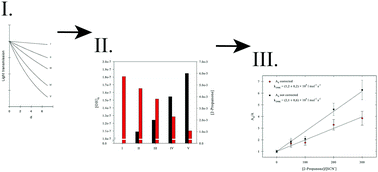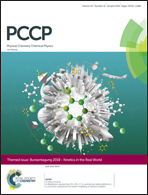Competition kinetics of OH radical reactions with oxygenated organic compounds in aqueous solution: rate constants and internal optical absorption effects†
Abstract
Oxygenated organic compounds are omnipresent in the troposphere, due to their strong emissions from either biogenic or anthropogenic sources. Additionally, the degradation and oxidation processes of volatile organic compounds (VOCs) result in the production of oxygenated organic compounds in the troposphere. The degradation and conversion of these compounds are often initiated by radical reactions and occur in the gas phase as well as in the aqueous phase, including cloud droplets, fog, haze, rain or hygroscopic particles containing ‘aerosol liquid water (ALW)’. In the present study, the temperature-dependent OH radical reactions with oxygenated organic compounds in the aqueous phase have been investigated by laser flash photolysis. To determine the rate constants, the OH radical – thiocyanate anion competition kinetics method has been used. Once the organic reactant has an absorption at the excitation wavelength of the photolysis laser, the initial OH concentration decreases. This internal absorption effect leads to an overestimated rate constant of the investigated compound. The present study considers this contribution in order to clarify the internal absorption effect of the investigated organic compounds. The following rate constants for OH radical oxidation reactions of the oxygenated organic compounds have been obtained: acetone (2-propanone) k298K = (7.6 ± 1.0) × 107 L mol−1 s−1, 1-hydroxypropan-2-one k298K = (1.1 ± 0.1) × 109 L mol−1 s−1, 1,3-dihydroxypropan-2-one k298K = (1.5 ± 0.1) × 109 L mol−1 s−1, 2,3-dihydroxypropanal k298K = (1.3 ± 0.1) × 109 L mol−1 s−1, butane-1,3-diol k298K = (2.5 ± 0.1) × 109 L mol−1 s−1, butane-2,3-diol k298K = (2.0 ± 0.1) × 109 L mol−1 s−1 and hexane-1,2-diol k298K = (4.6 ± 0.4) × 109 L mol−1 s−1. With the rate constants obtained and their T-dependencies, the source and sink processes of oxygenated organic compounds in the tropospheric aqueous phase are arrived at precisely. These findings might enhance the predictive capabilities of models such as the chemical aqueous-phase radical mechanism (CAPRAM).

- This article is part of the themed collection: Bunsentagung 2018: Kinetics in the Real World


 Please wait while we load your content...
Please wait while we load your content...